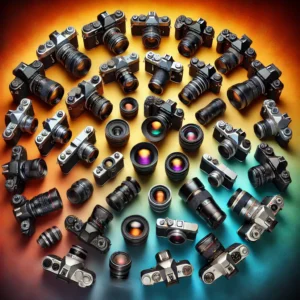Photography is more than just a hobby. It’s a way to capture the world as you see it. And when we talk about impressive photos, camera lenses play a huge role. They are like a photographer’s magic wand. Whether you’re a beginner or a pro, the right lens can make all the difference. In 2025, there are plenty of new options that can take your photography to the next level. Let’s take a look at what lenses are out there waiting for you.
Key Insights
- Camera lenses are crucial for the quality of your photos.
- Prime lenses often offer sharper images than zoom lenses.
- Zoom lenses are ideal for flexibility in various situations.
- Macro lenses open up the world of small details.
- The choice of the right lens depends on your photography style.
Why Camera Lenses Are the Key to Impressive Photography
The Magic of Focal Length
Camera lenses are more than just a piece of glass in front of your camera. They are the gateway to your creativity. The focal length is a crucial factor that influences how much of the scene you can capture. A short lens shows you the whole world, while a long lens helps you discover distant details. If you want to learn more about focal length, check out how it can affect the angle of view and zoom.
Aperture: More Than Just a Technical Detail
Aperture might sound complicated, but it’s super important. It determines how much light your lens can capture. A fast lens allows you to take great photos even in low light. It gives you the freedom to play with depth of field and highlight your subjects. Imagine being able to shoot in a dark room without using a flash – that’s the magic of aperture.
How Lenses Unleash Your Creativity
Lenses are like brushes for painters. They help you bring your visions to life. Whether you want to capture a portrait with a blurred background or a landscape with clear details, the right lens makes it possible.
With the right lens, you can take your photography to the next level without having to be a pro. It’s about showing the world from your own perspective and having fun doing it.
At the end of the day, it’s the lenses that help you get the most out of your camera. They are the key to making your photographic dreams come true.
Prime Lenses: The Secret Weapon for Sharp Images
Why Prime Lenses Are Unbeatable
Prime lenses are like the Swiss Army knife in photography – they are versatile and indispensable. The main advantage lies in their sharpness. Without the complexity of a zoom mechanism, prime lenses can deliver image quality that is simply stunning. You’ll find that the photos are crisper and more detailed. They also often have a larger aperture, which captures more light and is ideal for low-light shooting. These lenses are also lighter and more compact, making them perfect for on-the-go.
The Best Prime Lenses for Portraits
For portraits, prime lenses are a must. They allow you to separate your subject from the background with a beautiful bokeh effect. Some of the most popular focal lengths for portraits are 50mm, 85mm, and 135mm. These lenses offer a natural perspective and a pleasing compression that flatters facial features. If you want to dive into the world of portrait photography, you should definitely try one of these lenses.
Landscape Photography with Prime Lenses
Prime lenses can also shine in landscape photography. With their excellent sharpness and detail, you can capture breathtaking landscapes. A 35mm lens is often the first choice for landscape photographers because it offers a wide field of view without distorting the perspective. However, if you’re feeling more adventurous, a 24mm lens might be just right for you. It gives you the opportunity to capture even more of the scene and create creative compositions.
Prime lenses are not just tools, they are your creative partners. They challenge you to move and discover new perspectives.
And if you want to learn more about the latest developments, check out the new prime lens for E-Mount coming to market in 2025. It might be just what you need for your photography.
Zoom Lenses: Flexibility for Every Occasion
Advantages of Zoom Lenses
Zoom lenses are like the Swiss Army knife in your camera bag. They give you the freedom to cover different focal lengths without changing lenses. Imagine you’re on a trip and need to quickly switch from a portrait to a landscape – with a zoom lens, it’s a breeze.
Another big advantage is the versatility. Whether you’re in the city or exploring nature, zoom lenses adapt to your needs. You save not only space in your gear but also time, as you don’t have to constantly change lenses.
The Versatility of Travel Zooms
Travel zooms are made especially for adventurers. They are compact and lightweight, perfect for on-the-go. These lenses allow you to cover everything from wide-angle to telephoto. Especially handy when traveling, when you don’t have much space for gear.
Here are a few things you can do with a travel zoom:
- Photograph cityscapes and architecture
- Capture snapshots of people and moments
- Nature shots from mountains to small details
Zoom Lenses for Sports Photography
When it comes to sports, you need speed and precision. Zoom lenses allow you to quickly react to the action. Whether you’re photographing a soccer game or a car race, a zoom lens lets you flexibly respond to distance and perspective.
With a zoom lens, you’re always ready to capture the perfect moment without losing valuable seconds.
And if you’re looking for a new lens, keep an eye out for the new Laowa zoom macro lens from Venus Optics, which is coming to market soon and could be an exciting addition to your collection.
Macro Lenses: Discover the World of Details
The Fascination of Macro Photography
Have you ever seen a bee on a flower so close that you could count the tiny hairs on its body? Macro lenses open up this world full of details that are often overlooked. With these special lenses, you can capture subjects on a scale that is simply not possible with regular lenses.
- Magnification: Achieve a scale of 1:1 or even larger.
- Detail: Discover details that you can’t perceive with the naked eye.
- Creativity: Play with depth of field and perspectives.
The Right Technique for Macro Shots
Technique is crucial to getting the most out of your macro lens. Here are a few tips that can help you:
- Use a tripod: For absolute sharpness, especially in low light.
- Manual focus: Rely on your eyes to find the perfect focus.
- Adjust the aperture: Play with the aperture to achieve the desired depth of field.
Macro photography requires patience and a willingness to experiment, but the results are often breathtaking and rewarding.
Macro Lenses for Nature Photographers
For nature photographers, macro lenses are an indispensable tool. They allow you to capture the hidden beauty of nature in an impressive way. Whether it’s the structure of a leaf or the compound eye of a fly, with a macro lens you can dive into a new dimension.
A highlight this year is the new macro design-first lens from Canon, expected in the first half of 2025. It promises to take macro photography to a new level and could be just what you need for your next photo safari.
Wide-Angle Lenses: More Than Just Landscapes

Architectural Photography with Wide-Angle
With wide-angle lenses, you can really shine in architectural photography. These lenses capture wide views and are ideal for emphasizing the size and structure of buildings. When you’re in the city, try pointing the camera upwards and capturing the lines of skyscrapers. The result can be truly impressive! A little tip: Make sure the lines aren’t too distorted by keeping the camera as straight as possible.
Creative Possibilities with Wide-Angle
Wide-angle lenses aren’t just for landscapes and architecture. They offer you a creative playground to try out unusual perspectives. Imagine you’re at a concert and want to capture the whole stage and the crowd. With a wide-angle lens, no problem! Even in tight spaces, like at parties or family gatherings, you can capture more of the scene without constantly having to back up.
Wide-Angle in Street Photography
In street photography, wide-angle lenses help you capture the moment in all its fullness. You can tell stories by including both the main subject and the surroundings in the picture. A wide-angle lens allows you to get close to the scene and still capture a lot of the environment. This gives your images depth and context. Imagine you’re at a bustling market – with a wide-angle lens, you can perfectly capture the hustle and bustle.
Wide-angle lenses are versatile tools that go far beyond classic landscape photography. They open up new perspectives and invite you to discover the world with your camera in your own unique way.
Telephoto Lenses: Capturing the World from Afar
Wildlife Photography with Telephoto Lenses
Do you want to photograph lions in the savannah or birds in flight? Then telephoto lenses are just right for you. They bring you closer to the action without disturbing the animals. A good telephoto lens is worth its weight in gold when you need to work from a safe distance. Look for a high focal length and good aperture so your images are still sharp at dusk.
Photographing Sports Events from a Distance
Whether it’s a soccer game or athletics – with a telephoto lens, you’re in the middle of the action, even if you’re sitting far away. The speed of the autofocus is crucial here to capture the perfect moment. Image stabilization helps you take shake-free shots, even when things get hectic.
Telephoto Lenses for Astrophotography
The night sky offers countless subjects that you can discover with a telephoto lens. From moon craters to distant galaxies – with the right equipment, the universe becomes within reach. It’s important to use a tripod to keep the camera stable and take advantage of long exposure times.
With telephoto lenses, a whole new world of photography opens up to you. They allow you to capture details that are often hidden from the naked eye. Whether in nature, sports, or the night sky – the possibilities are endless.
Specialty Lenses: Creative Effects for Your Photos
Fisheye Lenses for Unique Perspectives
With a fisheye lens, you can see the world from a whole new angle. These lenses intentionally distort the image to create a spherical effect. Perfect for creative experiments or to spice up boring subjects. Imagine standing in the middle of the city and all the buildings bend around you – that’s the magic of the fisheye effect.
Tilt-Shift Lenses for Architecture
Tilt-shift lenses are the secret trick of many architectural photographers. They make buildings appear straight and proportional, even when you’re shooting from an oblique angle. But that’s not all! You can also create the miniature effect, where the world looks like a toy land. A bit tricky to use, but the results are worth it.
Lensbaby and Other Creative Options
Lensbaby lenses offer you the opportunity to play with focus and give your images a dreamy look. They are perfect for directing the viewer’s attention to a specific point in the image. Other creative options include lenses with special filters or effects that make your photos unique.
Sometimes it’s the challenge of photographing with limitations that really unleashes creativity.” Engage in creative photography in 2025.
Specialty lenses can take your photography to the next level and help you realize your artistic vision. Try them out and discover the endless possibilities!
Buying Guide: How to Find the Perfect Camera Lens

What to Look for When Buying
When buying a camera lens, there are a few things you should definitely consider. First of all, the focal length is crucial. It determines how far or close you can bring your subject. Think about what you mainly want to photograph: portraits, landscapes, or maybe sports events?
Another point is the aperture. The lower the f-number, the better for low-light shooting. And then there’s the weight. A heavy lens can get pretty annoying in the long run, especially if you’re on the go a lot.
The Importance of Compatibility
Not every lens fits every camera. Compatibility is the keyword here. Find out if the lens is compatible with your camera model. There are adapters, but they can affect quality. Pay attention to the right mount and read a few reviews.
Budget Tips for Lens Buyers
You don’t have to spend a fortune to take good photos. There are many affordable lenses that deliver great results. Think about what you really need and set priorities.
- Buy used: There are often lenses in good condition for less money.
- Kit lenses: These are often cheaper in a set with a camera.
- Discounts and offers: Keep an eye out for promotions, especially at the end of the year when new camera models are introduced.
In the end, it’s not the most expensive equipment that counts, but how you use it. Don’t be dazzled by big names, but find the lens that suits your style.
Conclusion
So, folks, if you want to take really cool photos in 2025, you need the right lenses. There are so many options out there that it can be really hard to decide. But don’t worry, with a little research and experimentation, you’ll surely find the perfect lens for your needs. Whether you want to capture landscapes, portraits, or the small details of everyday life – the right lens makes the difference. So grab your camera and start experimenting. Have fun photographing!
Frequently Asked Questions
Why are camera lenses so important for good photos?
Lenses are like the eyes of the camera. They determine how light hits the sensor and thus greatly influence the image quality.
What is the difference between prime lenses and zoom lenses?
Prime lenses have a fixed focal length and often offer better image quality. Zoom lenses are more versatile as they can cover different focal lengths.
Why should I use a macro lens?
Macro lenses are ideal for making small things appear large. They let you discover details that you can hardly see with the naked eye.
Are wide-angle lenses only suitable for landscapes?
No, wide-angle lenses are also great for architecture and creative shots where you want to get a lot in the picture.
When is a telephoto lens useful?
A telephoto lens is perfect when you want to photograph distant subjects, like animals in the wild or athletes in a stadium.
What are specialty lenses?
Specialty lenses offer special effects, like fisheye for round images or tilt-shift for miniature effects, and open up new creative possibilities.



